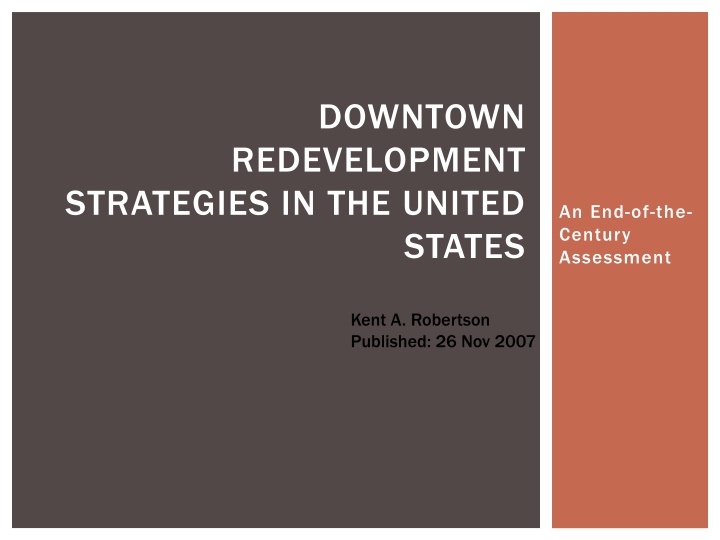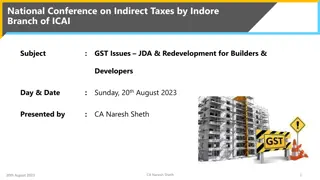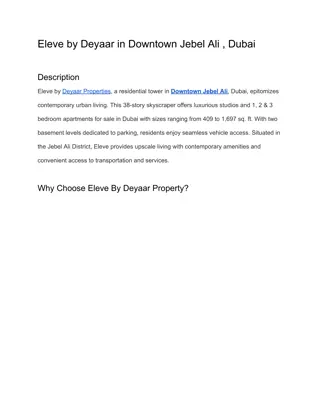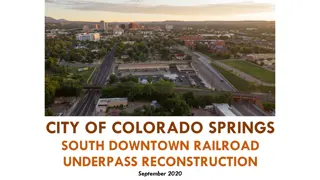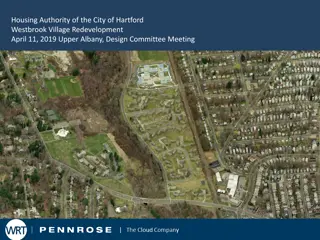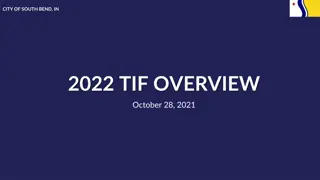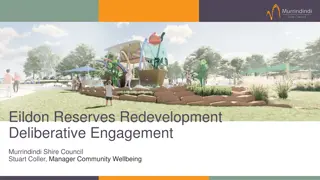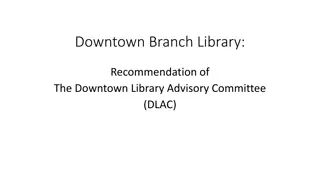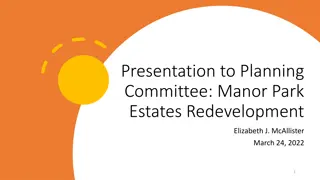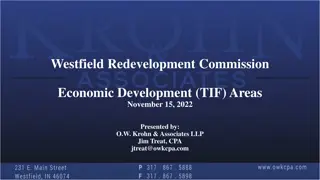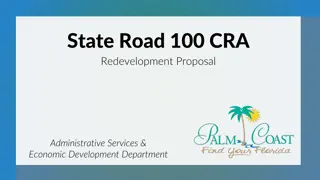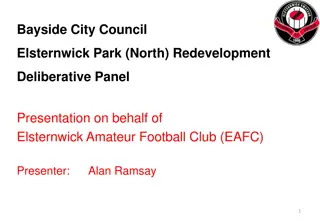American Downtown Redevelopment Strategies: An End-of-the-Century Assessment
American downtown districts have evolved over time in response to changing technologies and socioeconomic patterns. This evolution includes factors shaping policy at national and metropolitan levels, such as transportation developments and economic activities like retailing, offices/finance, and entertainment. The decline of American downtowns since the 1920s has been influenced by decentralization to suburban areas and the rise of automobile use, impacting pedestrian friendliness and urban fabric. Explore the historical context and challenges faced by American downtown areas in this insightful assessment.
Download Presentation

Please find below an Image/Link to download the presentation.
The content on the website is provided AS IS for your information and personal use only. It may not be sold, licensed, or shared on other websites without obtaining consent from the author.If you encounter any issues during the download, it is possible that the publisher has removed the file from their server.
You are allowed to download the files provided on this website for personal or commercial use, subject to the condition that they are used lawfully. All files are the property of their respective owners.
The content on the website is provided AS IS for your information and personal use only. It may not be sold, licensed, or shared on other websites without obtaining consent from the author.
E N D
Presentation Transcript
DOWNTOWN REDEVELOPMENT STRATEGIES IN THE UNITED An End-of-the- Century Assessment STATES Kent A. Robertson Published: 26 Nov 2007
THE DECLINING AMERICAN 1 DOWNTOWN
American downtown districts, unlike suburban shopping malls or office complexes, were not created in a particular era, but evolved gradually in response to changing technologies and socioeconomic patterns, and to factors affecting policy at both the national and metropolitan levels. Early 20th century, shaped by pedestrian traffic and mass transit, particularly the electric streetcar- (radial configuration that converged on the downtown, making it the most accessible part of the city and bringing thousands of workers, shoppers, and visitors there) The major economic activities were retailing, offices/finance, and entertainment
MIDDLE OF THE 19TH CENTURY, CHICAGO EMBARKED ON A QUEST TO LITERALLY LIFT ITSELF OUT OF THE MUD
A downtown office/financial district also developed early in the century, for these reasons: (1)expanding industry needed more space for management functions; (2) businesses sought locations near support services (e.g., printing, banking, legal) and competing or complimentary businesses; (3) (3) impressive buildings at prestigious business addresses were sought after.
After reaching its pinnacle during the 1920s, however, the American downtown has steadily declined. Decentralization has shifted downtown functions to the surrounding suburbs, particularly since World War Two. Rising automobile use has allowed activities that had been the exclusive domain of down- town to follow middle-class residents to suburbia. In 1954, downtown retail sales still accounted for nearly 20 percent of the nationwide metropolitan total; by 1977, only 4 percent of metropolitan sales occurred downtown downtown San Jose in the 1950s. Much of the urban fabric shown has since been redeveloped into new office, housing or retail. Some of the buildings shown have come down, and the lots remain vacant today.
Downtowns became less pedestrian-friendly. Distances between activities increased, making them less walk able; sidewalks narrowed, to widen streets for more automobiles; walking came to seem more dangerous, from both heavy traffic and increased down- town crime; and reduced on-street activities (e.g., shops, other pedestrians) made walking less of a plea- sure.
MAJOR DOWNTOWN MAJOR DOWNTOWN REDEVELOPMENT REDEVELOPMENT STRATEGIES STRATEGIES 2
PEDESTRIANIZATION making downtown more pedestrian-friendly will improve traffic management, economic revitalization, and environ- mental quality a more attractive image of downtown for potential users. Pedestrian malls are of three types: 1)traditional pedestrian streets, designed for pedestrians only, 2 ) allow limited automobile traffic, and 3) transit malls, which accommodate both transit and pedestrian use 2 ) shared malls, which only a handful of American cities built skywalks during the 1960s. skywalks have some problems(reduce the value of ground-level space; damage the facades of older downtown buildings; potential to segregate people by social class)
INDOOR SHOPPING CENTERS INDOOR SHOPPING CENTERS Americans have shown a strong preference for climate-controlled indoor environments. many down-towns try to compete with the suburbs by constructing an indoor shopping mall downtown. Share key characteristics: centralized management, a carefully planned retail mix, the domination of national chains over local independents, and a clean, se- cure, attractive, and climate-controlled environment. Due to higher land costs-and the lack of free parking. three types of downtown centers emerged: 1) regional shopping malls centered around traditional anchor department stores, 2) mixed-use centers, which integrate retailing with a hotel, transit terminal, or convention center, and 3) festival market- places, which offer a series of unusual shops, emphasize food and entertainment Drawbacks self-contained structures distance-decay effect encourage commercial gentrification, criticized for aesthetic reasons.
HISTORIC PRESERVATION HISTORIC PRESERVATION Two preservation projects common in larger cities are festival marketplaces and special historic districts. The festival markets differ from traditional shopping malls in the following ways: (1)their unusual mix of local specialty shops, (2) the lack of anchor department stores, (3) (3)the strong emphasis on entertainment and food, (4) the importance of historic and/or architectural themes, and (5) their specialized target market-affluent, well- educated, young adults.
WATERFRONT DEVELOPMENT WATERFRONT DEVELOPMENT The sight, sound, and feel of water naturally at- tract people, which is why waterfront developments often prosper. this strategy offers the public an amenity not often found in the suburbs people usually were cut off from city waterfronts by factories A major issue for downtown waterfront plans is the competition among possible uses that are often incompatible: industry, fishing, commerce, housing, recreation, open space, and tourism. water- dependent uses water-related uses water- enhanced uses, choice between using waterfront property for private development and using it for public open space.
OFFICE OFFICE DEVELOPMENT DEVELOPMENT The office sector is a critical component in the vitality of American downtowns. transform downtowns into centers of financial, administrative, and professional services One consequence of the corporate center approach is an increase in downtown mixed-use mega structures, that is, office towers combined with retail malls or hotels. The pre-existing office spaces became harder to lease, so vacant and devalued space abounded; reduced the city tax base. cities may have overinvested in public service systems that will not be fully utilized; have a negative effect on the areas around thus diminishing other downtown activities. (reduce the usage) The boom in office development did increase the open spaces downtown.
SPECIAL ACTIVITY GENERATORS SPECIAL ACTIVITY GENERATORS This strategy has three objectives. First, the facility should pro-duce spillover benefits Second, the facility should stimulate new construction Third, the facility can be located where it may revitalize a blighted area.
TRANSPORTATION ENHANCEMENT TRANSPORTATION ENHANCEMENT Travel time, inconvenience, traffic congestion, safety anxieties, and parking. 1) creating high-occupancy lanes on approach highways, which cars with only one occupant cannot use, 2) 2)designing emergency systems to clear downtown roads and highways of disabled vehicles more quickly, and 3) applying traffic engineering techniques such as signalization, turn lanes, and one-way streets. All downtowns face the challenge to accommodate the automobile while remaining hospitable to pedestrians and transit users.
OTHER DOWNTOWN OTHER DOWNTOWN REDEVELOPMENT REDEVELOPMENT STRATEGIES STRATEGIES 3
Several others deserve mention: housing, hotels, entertainment and cultural attractions. housing, hotels, entertainment, Adds activity to downtown streets on evenings and weekends, and creates a greater sense of security. New high-rise buildings, adaptive reuse of old structures such as warehouses and mills, and low-rise town-houses have increased downtown housing. New hotels appear when downtowns invest in special activity facilities restoring old theatres, adding new attractions (i.e., aquariums, casinos, movie theatres, arenas), and promoting downtown s restaurants and nightlife
THE UNEVEN EFFECTS OF DOWNTOWN DEVELOPMENT STRATEGIES 4
one can argue that without these efforts many downtowns would have even fewer activities and amenities than they now do, and some might have died altogether. dual cities (1)represent a modern, business-oriented downtown(2)During the evenings and on weekends, when the office buildings are empty, activity ceases; American down-towns is that they are losing density (automobile, large- scale construction of parking lots and ramps) Increasingly, cities rely on tourism as an economic stimulus for downtowns. (unless tourism is carefully integrated with the overall downtown plan, can harm other downtown activities and nearby residential areas) Set downtown apart within the region, and particularly from suburbia
SHAPING AN AGENDA FOR SHAPING AN AGENDA FOR 5 DOWNTOWN DOWNTOWN DEVELOPMENT DEVELOPMENT
Looking toward the 21st century, downtowns should work towards stronger identities; each city should identify the uniqueness of its downtown. The author offered several recommendations:
Maintain high density levels. Emphasize historic preservation. Do not suburbanize downtown. Maintain and/or develop true civic public spaces Develop and enforce strict design controls on new development, to ensure that the project integrates effectively with the downtown. Do not underestimate the importance of street level activity. Plan for a multi-functional downtown.
